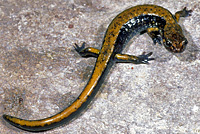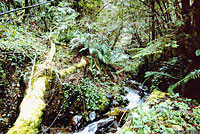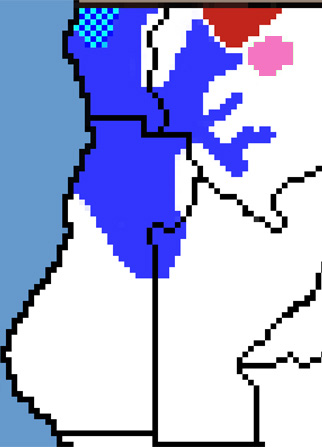|
 |
| Adult, Del Norte County |
 |
 |
 |
| |
Adult, Del Norte County |
|
 |
 |
 |
| Adult, Del Norte County |
Adult, Del Norte County |
Adult, Del Norte County |
 |
 |
 |
| Adult, Del Norte County © Alan Barron |
Adult, Del Norte County
© Spencer Riffle |
 |
 |
 |
| Adult, Del Norte County © Alan Barron |
Adult, Del Norte County
© Spencer Riffle |
Adult, Del Norte County
© Spencer Riffle |
 |
 |
 |
| Adult, Del Norte County © Ryan Sikola |
 |
 |
|
| Adult, Del Norte County © Ryan Sikola |
Adult, Del Norte County © Spencer Riffle
The stripe on top of the tail of Dunn's salamander does not extend to the end of the tail. (This is useful when comparing Dunn's with the Western Red-backed Salamander, whose tail stripe does extend to the end of the tail where it occurs north of California.
|
|
| Juveniles |
 |
 |
|
Hatchling, Del Norte County
© Spencer Riffle |
Juvenile, Del Norte County
© Alan Barron |
|
| |
|
|
| Dunn's Salamanders From Outside California |
 |
 |
 |
| Adult, Hood River County, Oregon |
Adult, Multnomah County, Oregon |
|
Click here to see more pictures of Dunn's Salamander from the Northwest.
|
| Habitat |
 |
 |
 |
Habitat, 1200 ft., Del Norte County
|
Habitat, 400 ft., Del Norte County |
Habitat, Del Norte County |
| |
|
|
| Short Videos |
 |
 |
|
| A Dunn's Salamander is found under a rock at the edge of a mountain stream in Oregon. |
Dunn's on the run. Like many salamanders when they move quickly, this one seems to hurl itself forward totally out of control while wriggling its long body from side to side. |
|
|
|
|
| Description |
| |
| Size |
2 - 3 inches (5 - 7.6 cm) snout to vent length, up to 6 inches (15.4 cm) total length.
|
| Appearance |
A large elongated salamander usually with 15 costal grooves.
The tail is slightly flattened. |
| Color and Pattern |
Color is dark brown or black with an uneven-edged tan, yellow, or greenish yellow dorsal stripe which does not extend to the end of the tail.
The stripe is flecked with dusky color which may conceal it.
There are blotches of the dorsal stripe color on the sides.
Dark unstriped melanistic individuals have been found along with striped individuals.
The belly is slate-colored with small yellowish orange spots. |
| Juveniles |
Juveniles have a brighter and more even-edged dorsal stripe than adults.
|
| Life History and Behavior |
A member of family Plethodontidae, the Plethodontid or Lungless Salamanders.
Plethodontid salamanders do not breathe through lungs. They conduct respiration through their skin and the tissues lining their mouth. This requires them to live in damp environments on land and to move about on the ground only during times of high humidity. (Plethodontid salamanders native to California do not inhabit streams or bodies of water but they are capable of surviving for a short time if they fall into water.)
Plethodontid salamanders are also distinguished by their nasolabial grooves, which are vertical slits between the nostrils and upper lip that are lined with glands associated with chemoreception.
All Plethodontid Salamanders native to California lay eggs in moist places on land.
The young develop in the egg and hatch directly into a tiny terrestrial salamander with the same body form as an adult.
(They do not hatch in the water and begin their lives as tiny swimming larvae breathing through gills like some other types of salamanders.) |
| Activity |
Terrestrial.
Can be active on rainy or wet nights any month of the year, but most surface activity is in Fall and Spring.
During hot and dry conditions, they move deep into rocky talus or rock cracks, or retreat to wetter streamside habitats where they can be abundant under wet streamside rocks.
Fairly tolerant of cold conditions, but probably goes underground during freezing conditions.
May be active year-round in along the coast.
|
| Defense |
Adults can quickly run for cover when disturbed, but sometimes they remain motionless to avoid detection.
|
| Diet and Feeding |
| Eats small invertebrates, including worms, centipedes, scorpions, millipedes, moths, mites, bees, wasps, ants, and beetles. |
| Reproduction |
Little is known about the breeding behavior of this species.
Reproduction is terrestrial.
Gravid females have been found year-round, so courtship might take place over an extended period. |
| Eggs |
Females presumably lay and brood eggs underground in rocky habitats during spring and early summer, but this is not certain.
One egg mass consisting of nine eggs in a grape-like cluster was found in Oregon on July 6th, 1952.
|
| Young |
Young develop completely in the egg and hatch fully formed probably in early Fall.
|
| Habitat |
Associated with rocks, typically along stream banks, seepages and other aquatic sites in forests.
Often found in the splash zone or under rocks and woody debris on shaded stream banks.
Prefers semiaquatic locations, but often found away from water during the rainy season in the Cascade Mountains of Oregon.
|
| Geographical Range |
In California, found only in the Smith River area of northwest Del Norte County.
The total range of this species extends from southwest Washington, south along the Pacific Coast mountains into extreme northwest California, and in the Oregon Cascade Mountains south of the Columbia River. It is not present in the Washington Cascade Mountains.
|
 |
| Notes on Taxonomy |
Alternate and Previous Names (Synonyms)
Plethodon dunni - Dunn's Salamander (Stebbins 2003, 2012)
Plethodon dunni - Dunn Salamander (Stebbins 1985)
Plethodon dunni - Dunn's Salamander (Stebbins 1954, 1966)
Plethodon dunni - Dunn's Salamander (Western Tan-backed Salamander) (Bishop 1943)
|
| Conservation Issues (Conservation Status) |
No known issues.
This species is found in old growth and logged forests, but is absent or reduced in clearcut forests.
Protected from take with a sport fishing license in 2013. |
|
| Taxonomy |
| Family |
Plethodontidae |
Lungless Salamanders |
Gray, 1850 |
| Genus |
Plethodon |
Woodland Salamanders |
Tschudi, 1838 |
Species
|
dunni |
Dunn's Salamander |
Bishop, 1934 |
|
Original Description |
Bishop, 1934 - Proc. Biol. Soc. Washington, Vol. 47, p. 169
from Original Description Citations for the Reptiles and Amphibians of North America © Ellin Beltz
Eponyms
First described by Bishop in 1934, the specific name "Plethodon dunni" and the common name "Dunn's Salamander" honor Emmett Reid Dunn (1894-1956), and American herpetologist noted for his studies of salamanders in the Eastern U.S.A.
See: Biographies of Persons Honored in the Herpetological Nomenclature © Ellin Beltz
|
|
Meaning of the Scientific Name |
Plethodon - Greek- plethore = fullness or full of + odon = teeth - refers to the number of vomerine & pre-vomerine teeth
dunni - honors Emmett R. Dunn
from Scientific and Common Names of the Reptiles and Amphibians of North America - Explained © Ellin Beltz
|
|
Similar Neighboring Salamanders |
Del Norte Salamander
Siskiyou Mountains Salamander
|
|
More Information and References |
AmphibiaWeb
Hansen, Robert W. and Shedd, Jackson D. California Amphibians and Reptiles. (Princeton Field Guides.) Princeton University Press, 2025.
Stebbins, Robert C., and McGinnis, Samuel M. Field Guide to Amphibians and Reptiles of California: Revised Edition (California Natural History Guides) University of California Press, 2012.
Stebbins, Robert C. California Amphibians and Reptiles. The University of California Press, 1972.
Flaxington, William C. Amphibians and Reptiles of California: Field Observations, Distribution, and Natural History. Fieldnotes Press, Anaheim, California, 2021.
Nicholson, K. E. (ed.). 2025. Scientific and Standard English Names of Amphibians and Reptiles of North America North of Mexico, with Comments Regarding Confidence in Our Understanding. Ninth Edition. Society for the Study of Amphibians and Reptiles. [SSAR] 87pp.
Samuel M. McGinnis and Robert C. Stebbins. Peterson Field Guide to Western Reptiles & Amphibians. 4th Edition. Houghton Mifflin Harcourt Publishing Company, 2018.
Stebbins, Robert C. A Field Guide to Western Reptiles and Amphibians. 3rd Edition. Houghton Mifflin Company, 2003.
Behler, John L., and F. Wayne King. The Audubon Society Field Guide to North American Reptiles and Amphibians. Alfred A. Knopf, 1992.
Robert Powell, Roger Conant, and Joseph T. Collins. Peterson Field Guide to Reptiles and Amphibians of Eastern and Central North America. Fourth Edition. Houghton Mifflin Harcourt, 2016.
Powell, Robert., Joseph T. Collins, and Errol D. Hooper Jr. A Key to Amphibians and Reptiles of the Continental United States and Canada. The University Press of Kansas, 1998.
American Museum of Natural History - Amphibian Species of the World 6.2
Bartlett, R. D. & Patricia P. Bartlett. Guide and Reference to the Amphibians of Western North America (North of Mexico) and Hawaii. University Press of Florida, 2009.
Bishop, Sherman C. Handbook of Salamanders. Cornell University Press, 1943.
Lannoo, Michael (Editor). Amphibian Declines: The Conservation Status of United States Species. University of California Press, June 2005.
Petranka, James W. Salamanders of the United States and Canada. Smithsonian Institution, 1998.
Corkran, Charlotte & Chris Thoms. Amphibians of Oregon, Washington, and British Columbia. Lone Pine Publishing, 1996.
Jones, Lawrence L. C. , William P. Leonard, Deanna H. Olson, editors. Amphibians of the Pacific Northwest. Seattle Audubon Society, 2005.
Leonard et. al. Amphibians of Washington and Oregon. Seattle Audubon Society, 1993.
Nussbaum, R. A., E. D. Brodie Jr., and R. M. Storm. Amphibians and Reptiles of the Pacific Northwest. Moscow, Idaho: University Press of Idaho, 1983.
|
|
|
The following conservation status listings for this animal are taken from the April 2024 State of California Special Animals List and the April 2024 Federally Listed Endangered and Threatened Animals of California list (unless indicated otherwise below.) Both lists are produced by multiple agencies every year, and sometimes more than once per year, so the conservation status listing information found below might not be from the most recent lists. To make sure you are seeing the most recent listings, go to this California Department of Fish and Wildlife web page where you can search for and download both lists:
https://www.wildlife.ca.gov/Data/CNDDB/Plants-and-Animals.
A detailed explanation of the meaning of the status listing symbols can be found at the beginning of the two lists. For quick reference, I have included them on my Special Status Information page.
If no status is listed here, the animal is not included on either list. This most likely indicates that there are no serious conservation concerns for the animal. To find out more about an animal's status you can also go to the NatureServe and IUCN websites to check their rankings.
Check the current California Department of Fish and Wildlife sport fishing regulations to find out if this animal can be legally pursued and handled or collected with possession of a current fishing license. You can also look at the summary of the sport fishing regulations as they apply only to reptiles and amphibians that has been made for this website.
|
| Organization |
Status Listing |
Notes |
| NatureServe Global Ranking |
|
|
| NatureServe State Ranking |
|
|
| U.S. Endangered Species Act (ESA) |
None |
|
| California Endangered Species Act (CESA) |
None |
|
| California Department of Fish and Wildlife |
SSC |
California Species of Special Concern |
| Bureau of Land Management |
None |
|
| USDA Forest Service |
None |
|
| IUCN |
|
|
California Department of Fish and Wildlife
AmphibiaWeb
|
|
 Red: Range in California
Red: Range in California






























